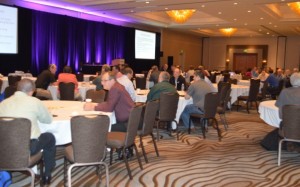
The final day of PesTech3.0 found attendees eager to learn more about Big Data.
The event was held in San Jose, Calif., also known as Silicon Valley, and sponsored by ServicePro, WorkWave, PestRoutes and PestMate.
Day three
Up first on the final day of PesTech3.0 was David Strom, an expert on network and Internet technologies, whose presentation was titled, “How Big Data Can Help Your Business.”
What is Big Data and why should you care, he asked attendees. Big Data is the information companies collect and manage.
“You don’t need to have a lot of data to have Big Data,” Strom said. You simply need learn how to take advantage of the Big Data your company has.
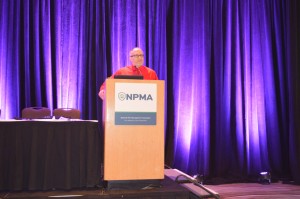
Using Big Data to boost your business was the subject of David Strom’s presentation.
And the value of Big Data for service and retail companies is huge because it can help companies improve sales interactions.
Big Data can help your business three ways, he said. First, it can enable you to predict what’s going to happen and heed early warning signs. Second, it can allow you to replicate your successes or float a new idea. Finally, Big Data can help you enhance customer engagement.
“It’s up to you to take the initiative and take advantage of Big Data,” Strom told attendees.
But first, you need to know where your data is stored. Is it on the cloud? Is it in the hands of a software vendor? Next, you need to figure out how to manipulate it. Fortunately, there are a lot of tools out there that are doing amazing things with Big Data, he said.
“You already have the data, now use it to your advantage,” Strom said. “The opportunity for you to gain knowledge is amazing.”
Even if you use a Rolodex, even if you’re a small company, you can unlock the value of your customer database, he said.
You can gain valuable insights using your data, however you probably won’t know what those will be until you start looking at it.
To collect more information on your customers, ask them. Consider using free survey services, such as SurveyMonkey.
He challenged attendees to “break out of your spreadsheet world” by converting data to easy-to-understand formats. Maps and dashboards are a few of the useful ways to look at Big Data.
His practical suggestions when it comes to Big Data included starting with just a little bit of data first, collecting as much data as possible, copying how other companies are using Big Data and attending local hackathons that software companies hold to learn firsthand how data is collected on the back-end.
Strom offered a five-step step plan: Don’t be shy about asking customers what they use; Define what you’re trying to measure; Take time to analyze customer feedback regularly; Make it easy for customers to provide feedback; and Take action!
As for what pest management companies can monitor, Strom suggested truck routes and fuel consumption, chemicals consumption, the most influential customers, the most problematic customers, and the service with the highest profits.
Boosting sales
Once you have a handle on your data, what do you do with it? The next presentation, “Increase Sales Through Customer Data You Already Have” answered that question.
Kevin Burns of Arrow Exterminators said he focuses on the information that is meaningful to his company.
“We’re trying to use the information to drive our sales,” he said.
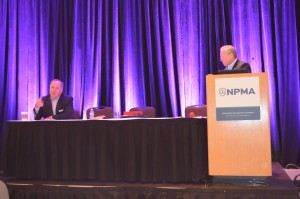
Kevin Burns and Billy Tesh (from left to right), shared how they use data to increase sales.
But not only does he analyze his business data, he uses data from other sources to gain valuable insights. For example, he uses Google and Zillow to find information about current and potential customers, including home values and median salaries.
“The information is right in front of you,” Burns said. “You can look at your customers a different way.”
You need a plan, he told attendees. “Think about all the data you have available to you and get granular,” he said. “Work in small chunks; it’s completely overwhelming. Success breeds success, so set realistic expectations.”
Billy Tesh, Pest Management Systems Inc., also uses data to boost sales.
He said technology makes it possible to avoid issues and problems that may go undetected. For example, the use of GPS in vehicles helps companies reduce liability, in the event of an accident, for example. In addition, geotracking lets companies so keep track of technicians’ location.
To set his company apart from other pest management companies, he bought a drone. He said it really helped his business and he can now complete inspections fasters.
Tesh said he uses his company’s data in a variety of ways. For example, he can glean where new customers learn of his company. A pie chart illustrated his point, showing how he used data to define where they come from and how much it costs to get each of those customers (for example, 53 percent come from the website at a cost of $47 each).
He also looks at his existing customer base to see if upselling is an option. He advised, however, that it’s important to understand technicians’ attitudes toward selling.
And like nearly every presenter at PesTech3.0, Tesh suggested the best way to learn how your customers feel about you is by offering them a survey. But make it short.

PesTech3.0 attendees check out the software and services exhibitors displayed the first day of the event.
Day two
On Jan. 6, John Foley Jr., founder and CEO of interlinkONE got day two off to a great start. This early adopter of new technology, whom Forbes magazine ranked the 15th most influential CMO on social media, presented, “How to Effectively Use Mobile to Market Your Business.”
John Foley Jr. discussed how to use mobile technology and social media.[/caption]After setting attendees straight on the definition of mobile marketing (it’s an activity conducted through a cellular network that lets you connect to your customers in the field), Foley provided useful advice on how pest management professionals (PMPs) could use technology to boost business.
“You are the one who can create what tomorrow is going to look like,” Foley said. “Don’t wait for it.”
There are several simple ways to separate your company from your competition, he said.
Posting videos is one way, as YouTube is the No. 2 search engine, behind Google, of course. Consider posting tips and tricks, a behind the scenes look at your company, or on-the-job encounters.
Connecting with customers on Facebook is another way to set your company apart with all the others. It’s enough to post content on the social media site. It’s better to engage with them by liking their posts.
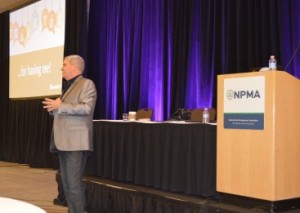
John Foley Jr. discussed how to use mobile technology and social media.
“When you can get your satisfied customer to engage with you, and post it on Facebook, you are a winner,” he said.
Nowadays, it’s very important for companies to “listen online” for word about their brands because negative information “spreads like wildfire on social media.”
It’s important to connect with customers, and companies need to understand why. Develop a mobile marketing strategy so you can measure your achievements and make changes if something isn’t working.
Make sure your website is mobile-friendly. Otherwise, your website won’t make it to the top of Google’s search engine results. Plus, 40 percent of consumers will choose another company if they need to pinch and zoom to see your content, or worse, your website doesn’t load fast enough on their mobile device. In addition, Google ignores non-mobile websites in its page rankings.
“Every time you post on social media, it helps your business,” Foley said. Provide information about how you can help your customers. Check your posts to make sure they are readable on mobile devices. Encourage customers to share your content.
“Use social media and get engaged,” Foley said. “There’s no sense in posting content all the time if nobody is there.”
Blogging is good way to start conversations with customers and grow your network. You better make it interesting, he said, because “no one wants boring.”
Electronic newsletters are also effective, especially if your goal is to generate leads.
“When someone signs up, they are telling you they want information from you once a month,” he said. Customers who subscribe will buy from you when they are ready.
“When it comes time to create a plan for your company’s mobile strategy, you better be able to measure it along the way,” Foley said.
Technology and sales
Next up was a panel discussion about using technology to increase sales and efficiency.
Bobby Jenkins, ABC Home & Commercial Services, told PesTech3.0 attendees about the app his company now uses to track leads.
The company, which pays its PMPs for leads whether or not they turn into a sale, always encouraged them to turn in customer leads. But because keeping track of them became increasingly difficult, the company needed to find a better way.
“The best opportunity for sales is the customer that exists and how the company can do more for them,” he said.
The Lead Now app, which is on every service person’s smartphone, ensures every lead that’s turned in will be accounted for.
PMPs simply snaps a photo of the customer’s problem, sends the information to the office, and the office contact the customer. About half the leads turned in result in a sale, he said. Having this technology at the PMP’s fingertips has made a difference.
Another app Jenkins’ company relies on is GoGetQuality. It allows his PMPs to build a relationship with the customer who typically is not home when the pest management services are performed.
It includes an emailed appointment confirmation; text notification of the PMP who is on the way to the job including a name, a photo and credentials; and emailed pictures of the conducive conditions along with a thank you for their business.
In addition to building a relationship, the app assures customers that the PMP showed up and completed the service.
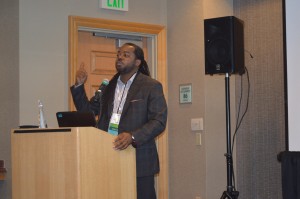
As the owner of a small pest management firm, Cleveland Dixon said outsourcing is the way to go.
He now uses RingCentral, a cloud based system that operates as a call center. He needed to train call center employees only once; any training of new hires is handled by the call center.
To further reduce office staff, Dixon said he uses Service Pro’s ServSuite to get customer information into his system, PDF Expert to get job information into his system, and Dropbox to store his files. Most recently, he hired a company to open his mail and scan any checks he receives.
Matt Beckwith of Clark Pest Control said his company uses technology to expedite and improve the customer experience.
“We need to communicate with customers,” he said. “What can we bring into the office to make it easier for customers to communicate with us?”
Turns out the answer is texting. Now, every company phone number allows for text messaging.
The phones for every branch of the company connect to a call center so they can speak to a live person. Texting is no different, as the company responds to all texts that come in during office hours within five minutes.
“You want customers to reach you in every possible way,” he said. “Customers can text, chat, email; any way we can get customers to reach us, we’re going to be there.”
Why not wear it
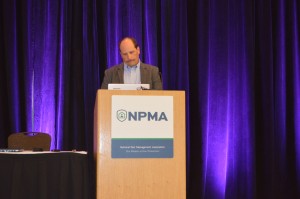
Wearable technology is becoming more commonplace, said Copesan’s Ari Rogoway.
After showing several innovative examples, he said one thing the PMPs struggle with is help in the field. Wearable technology may one day be a good solution.
“We’ve been using handhelds for a very long time now, and I think it’s time for something different,” he said.
Currently, wearables are geared more to fitness, but that will soon change.
Rogoway highlighted innovative watches, glasses, armbands and walking devices. Some of the wearables he showed seemed odd or cumbersome. Others, such as conductive textiles and tattoos, are still in the development stages. But perhaps that’s just because we’re not accustomed to them yet.
But the coolest wearable he demonstrated was a pair of conductive gloves that act like a Bluetooth handset. At only five bucks a pop, he bought them for his PMPs, and they actually use them.
Solving security issues

Compliance and security was the subject Steve Eyring and Megan Delany discussed with PesTech3.0 attendees.
It’s Megan Delany’s job to help companies deal with data breeches. The company she works for, Dentons U.S., helps management deal with vulnerabilities. She knows that if hackers can reach a company’s data, they will get it.
“Because of these new facts of life, front and center in regulators’ minds are how management will deal with these data breeches,” she said.
Currently, there are no federal regulations on how to deal with data breeches. Instead, state laws govern these issues. Unfortunately, it’s difficult to keep up with state regulations, particularly for companies with numerous locations.
“The business community thinks a federal regulation would be a good thing,” she said. “At some point, a federal bill will get over the finish line.”
Delany said the main sticking point in enacting a federal law has been, “Does the bill exempt a company from liability under state common law?”
Government agencies, such as the Federal Trade Commission (FTC) and the Federal Communications Commission (FCC) are stepping up when it comes to this issue.
Companies are being held to a strict liability now, she said. Every company needs to have a privacy policy, now that the responsibility has shifted to the business owner.
The attorney general in each state will be the cop on the beat to enforce these policies, so make sure your privacy policy addresses the issues regulators are honing in on.
“This is going to be an ongoing discussion in Washington,” she said. “Pay attention to ongoing legislation.”
Steve Eyring of WorldPay focused on credit card security. Although small businesses are finally implementing technology that allows consumers to use credit cards with chip technology, data breeches will continue to occur.
Companies must protect consumer data, he said. Fortunately, countless companies in other countries, where chip technology was adopted long ago, have worked out any kinks. For example, chip cards enabled Canada to reduce fraud by 60 percent and when used with a PIN reduced it by another 60 percent. America, however, is years away from full adoption.
Small businesses are now the easiest targets of data breeches. Using default passwords and a lack of firewalls compounds the problem. They should ask their software providers and payment processors for help.
“Stakeholders in the payment industry have a moral obligation to protect customers and their data,” he said. “Ask yourself what you are doing to protect your customer and employee data.”
Day One
On Tuesday, Jan. 5, NPMA President Russ Ives kicked off the event by welcoming attendees and encouraging them to learn more about technology over the course of the three-day event.
He recognized the Pest Control Operators of California for their assistance facilitating the event and presented the organization’s President-Elect, Mike Bullert, owner, Big Time Pest Control, Anderson, Calif., with a plaque.
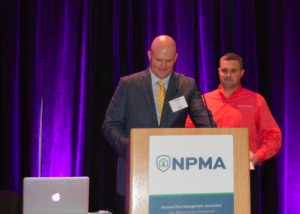
Mike Bullert, president-elect of the Pest Control Operators of California, and ServicePro’s Andy Deering, help kick off PesTech3.0.
Up next was Andy Deering, chief operating officer of ServicePro, Columbus, Ohio, a PesTech 3.0 sponsor, who introduced the event’s first speaker.
Evolving technology
Peter Leyden, founder and CEO of Reinventors, a network of innovators who use video to conduct interviews and facilitate discussions online, discussed what is going on in the world of technology.
He offered an historic view of how society has been reinvented and suggested technology is the impetus for more major changes.
“When we look back now, we will see the beginnings of a different way of running the country,” Leyden said.
Other eras of American reinvention occurred during the Civil War and around the turn of the 20th century.
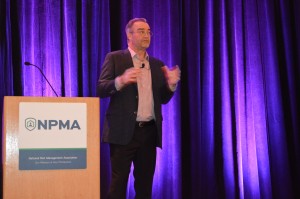
Peter Leyden, founder and CEO of Reinventors, discussed technological advances and how they change the world during day one of PesTech3.0.
“We are in a time of fundamental change,” he said, and we are moving from an unsustainable to a more sustainable way of doing things.
Factors facilitating change include video, Millennials, economics, clean energy and politics, Leyden explained.
“Long-term economic growth comes from new technology,” Leyden said. “It’s what created the boom in the 1950s and the same thing is happening now.”
He shared the ways in which new technology is adapted. It is first embraced by the innovators, then the early adopters, the early majority, the late majority, and finally the laggards come on board. Some technologies don’t get adopted after all, however.
Indeed, some market segments have embraced technology faster than others. For example, the consumer market has embraced technology whereas the healthcare industry has been slow to adapt.
That’s bound to change, now that Millennials are coming of age. In 2015, they comprised the largest segment of America’s workforce, displacing retiring Baby Boomers.
Leyden explained the difference between Millennials and Baby Boomers. The former are tech-savvy, collaborative, civic minded, racially diverse, global as many have spent some time abroad, and green. By contrast, the latter are media savvy, individualistic, indulgent, predominantly white, idealistic, and principled.
In fact, when an audience member asked, during the question-and-answer session at the conclusion of his presentation, how to work with Millennials, Leyden advised working with them “instead of thinking your way is the best way.” Allowing them to use Slack instead of email is one way to accomplish this.
Change is on the way, he told PesTech3.0 attendees.
“We are completely able to make a transition to an all digital society,” he said. “People will look back at this time period and say that’s when America reinvented itself.”
Leyden left the audience with some advice when it comes to keeping up with changes and new technologies. When a PesTech3.0 attendee asked which publications the former writer for Wired magazine now reads, he replied he gets his information through Twitter instead of magazines.
“Twitter is underutilized,” he said, and the social media site is where he learns the thought processes of the innovators he admires.
Disruptive technology
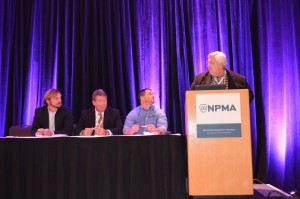
A panel discussion on Disruptive Technology featured, from left to right, Court Parker, Dennis Jenkins, Justin McCauley and Ray Johnson.
A panel discussion titled “Disruptive Technology” gave pest management business owners plenty of reasons to think long and hard about the ways in which they use technology.
Justin McCauley, McCauley Services, discussed the new technologies that are now being embraced by homeowners. These include motion detectors for the home, plant monitors that measure the amount of water in the soil, and remotely operated thermostats.
But what’s next, he asked, sensors that indicate the presence of pests?
Monitors that show only when a service is needed, as opposed to regularly scheduled maintenance visits, will be highly disruptive to the pest management industry.
New technology can be useful, however, as virtual reality may be “the next big thing” for training technicians.
Following Uber’s lead
Dennis Jenkins, ABS Home and Commercial Services, examined the possibility of the “Uberization” of the pest management industry.
He said several very real threats to traditional pest control exist now that consumers can now call companies such as Amazon and Angie’s List to handle pests.
“No matter what happens we will always have bugs,” he said. “How people buy from us is going to go through changes.”
To illustrate his point, Jenkins explained how Uber has become the preferred alternative to taking cabs.
“Uber is winning and Yellow Cab is losing, and that can happen to us,” he said.
It’s imperative that pest management companies follow Uber’s lead and make it easier for customers to buy and retain their services.
An app that makes it possible for customers to schedule, purchase and pay for services would be a good start. PMPs need to “deliver service in a whole new way,” Jenkins said.
Among the changes needed:
- GPS tracking on all vehicles, with a map that shows available vehicles;
- Time built into every day for techs to handle day-of calls;
- Ability to buy services online, including the scheduling of services;
- Communication with techs to make sure they get all dispatched calls; and
- Ability to authorize payment but not be charged until after the service is complete.
Sooner, rather than later, software vendors must deliver these types of services.
“We’ve got to be able to sell to our customers in a manner they want to buy from us,” he said.
Panelist Ray Johnson, Johnson Pest Control, ACES for Business and PMP columnist, told PesTech3.0 attendees, “A disruptive technology is a new emerging technology that unexpectedly displaces an established one.”
Social media is a disruptive technology, thanks to such sites as Yelp and Facebook.
“We live in a glass house,” he said. “Everything is transparent on social media.”
Bad reviews on Yelp can be devastating for those who receive bad reviews. Mobile devices that distract workers can also be a problem.
“It will be interesting to see what happens,” Johnson said.
Court Parker, Bug Busters Inc., offered a cautionary tale about cyber security.
Unfortunately, his company was attacked not once, but twice, despite his best efforts to provide protection.
The cost to his company cannot be measured, he said, as the second cyber attack essentially shut down operations.
In addition to losing money when the cyber attacks made work all but impossible, he said employees may now perceive management in an unfavorable light because it was unable to prevent the cyber attacks.
While the technical details on how the breaches occurred and were ultimately stopped may have been lost on some PesTech3.0 attendees, the reason for his presentation was clear. Be prepared, he warned.
Parker said he is worried that his customer information may be stolen some day, so he is taking steps to ensure it doesn’t happen. Cyber insurance is one way for pest management companies to protect themselves.
Leave A Comment